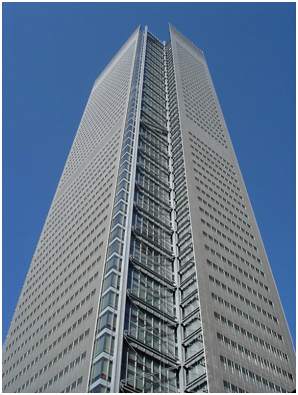The New York Times Building, New York
The New York Times building stands as one of the newest and most spectacular additions to Manhattan’s renowned skyline. The 52-story tower, completed in 2007, has won plaudits around the world for its unique, exposed steel “exo-skeleton” design and energy-efficient innovations such as the glass and steel curtain wall’s ceramic sunscreen. The project was a joint venture between The New York Times Company and Forest City Ratner Companies. The architects who designed the skyscraper are the world-renowned Renzo Piano and New York Architect FX Fowle (now FXCollaborative). The design features a glass curtain wall screened by ceramic tubes, yielding an energy conserving structure rising to 1046 feet at the top of the mast and an epoxy intumescent coating, combined with high-performance primer and topcoat materials, provided long-term protection to the skyscraper’s structural steel.
The competitive bidding process for the project began in 2003, with very specific criteria outlined to the coatings suppliers by FX Fowle, which served as architectural specifier for the project.
- The fire protection material selected would have to carry a minimum guarantee of a five-year lifecycle of performance.
- The application process would have to keep pace with an accelerated construction schedule.
- The material would need to meet a minimum two-hour fire protection rating, preferably higher.
The building was the first commercial high-rise structure in New York City to employ fire protection that goes beyond the standard ratings for cellulosic fires. The material used provides protection against extreme heat fires and blast pressure generated by major catastrophic events. This epoxy intumescent coating technology was developed by International Protective Coatings and formulated to protect steel structures from hydrocarbon and jet-steam fires in the oil, gas and petrochemical industries.
After the tragic events of September 11, 2001, research and development teams at International Protective Coatings used this proven coatings technology as the basis for development of the next generation of epoxy based intumescent fire protection, designed for use in the commercial building industry. The formulation for this coating provides excellent fire and anti-corrosion protection, but with the constructability and aesthetic versatility needed for exposed steel designs and multiple-application environments.
Epoxy intumescent coatings are paint-like materials that are applied to structural steel, and are designed to provide an insulating barrier between the steel and a fire. In the event of a fire, a chemical reaction causes the cured coating film to “intumesce,” or expand rapidly to many times its original thickness, and generate a foam-like or char layer that acts as an insulating barrier to prevent, or at least delay, failure of the structural steel. Epoxy intumescent coatings give extra time to evacuate the building and control the fire. These formulations are typically composed of a film-forming polymeric binder such as an epoxy or acrylic resin; a combination of chemical agents that react to trigger the fire-induced expansion of the coating film; pigments for opacity and colour; and other additives typically found in conventional coatings to provide application, cure, and long-term performance and appearance properties.
Some epoxy intumescent coatings require the addition of a reinforcing mesh when applied on specific structural shapes to ensure the integrity of the insulating or char layer.
International Protective Coatings took its new intumescent technology to the project’s contractor, AMEC Construction Management Inc. Two separate offsite field tests at the New York Times Company’s Queens facility, were conducted using steel mock-ups to assess the application, performance, and aesthetic characteristics of the coatings.
The coating system supplied by International Protective Coatings was found to offer construction advantages in both time and cost savings. It could be spray-applied in just one coat at a thickness of 80 or 120 mils (2000 or 3000 microns), depending on the dimensions of the steel beam/column and then back rolled to achieve the desired aesthetic look specified by the architects. Approximately 175,000 pounds (79,379 kilograms) of epoxy intumescent coating was used on the structure, without the use of mesh reinforcement. Combining this with a high performance primer and finish coat gave a high degree of fire protection while also offering long-term durability and long-term colour and gloss retention in exterior exposures to the 250,000 square feet of exposed steel, corner columns and cross beams.
Initial application of the intumescent coating began in 2005, after the first 10 floors of the 52-floor structure had already been erected. The organic zinc primer was shop applied to the steel by two different fabricators, Owen Steel and AFCO Steel which was then transported to the construction site for erection. On-site technical service support by International Protective Coatings ensured thorough training on the application of the material and proper repairs to any damage to the coated steel.
While the epoxy intumescent fire protection was selected for its long term performance, safety, and aesthetic capabilities, the technology also provides the building industry with the options of field or fabrication-shop application, offering building owners a choice of installation environments. Advantages associated with shop application certainly should be given serious consideration, as weather constraints and other onsite issues and equipment expenses, slowing productivity.
Additionally, architectural and engineering specifiers are increasingly seeking materials that support sustainable design methods. The fire-protective intumescent coating applied to the Times building is 100% solids, with zero VOC content. Upon the building’s grand opening in 2008, project developers and architects felt confident that they had achieved their goal of providing The New York Times Building and its 2500 Manhattan-based employees a safe, comfortable and energy-efficient work environment that only advanced design technologies could have provided.
| Architect | Renzo Piano Building Workshop and FX Fowle Architects |
| Structural Engineer | The Thornton Tomasetti Group, Inc |
| General Contractor | AMEC |
| Client | The New York Times Company and Forest City Ratner Companies. |




